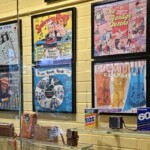The timing for this release couldn’t be better; in this bitter, ugly, acrimonious election season, it shows us how we can really get along so much better. It’s a detailed insight to how music– the real deal blues– unites cultures, as you see blacks and whites in the audience, and integrated bands too. It’s remarkable how well all interact together, and you’re left with a lasting impression of unity. The intended theme of the film is to portray the fading juke joint traditions, but the power of music as a uniting cultural force is the overriding takeaway. This is the perspective so many people need right now, as it couldn’t be further away from the news, the election ads and the ridiculous cable and radio talk shows that glorify hate and conflict.
This is also a must watch for true blues fans, as it pays tribute to a part of our history and to those dedicated to maintaining its relevancy. There are 20 songs in here – all done in traditional blues style, as noted jazz and blues filmmaker Robert Mugge focuses on two clubs – Morgan Freeman and attorney Bill Luckett’s Ground Zero in Clarksdale and Jimmy King’s legendary Subway Lounge in Jackson. In truth, these two clubs are more accurately described as “urban lounges” rather than juke joints, but each has tried to preserve the key juke joint traditions. The common elements, as described by Luckett and Freeman are: “pool tables, Christmas tree lights, beer signs and, to a lesser extent, recycled furniture.” It’s also important to have a low stage, one where musicians and audience can easily mingle. Along the way, Freeman talks about growing up in Greenwood, MS where, because of lots of fighting, juke joints were called “buckets of blood.” On the other hand, the Subway Lounge is described as “a conservatory of blues, R&B, and soul. We let people sit in. It’s the only place where whites and blacks can meet with common humanity.”
The documentary was first issued in 2003, but has only now been made available on DVD. The viewer has the option to play the soundtrack separately, and there is a short video update on the Subway Lounge, which for 30 years resided in the basement of the Summers Hotel. Due to reconstruction, the venue was closed in 2005. The story is told by historians Dick Waterman and Steve Cheseborough, by club owners, by politicians and by participating musicians. The musicians also demonstrate the different styles of Delta blues indigenous to the state. For example, Alvin Youngblood Hart performs with Sam Carr and very young Anthony Sherrod at Ground Zero. There are clips of Bobby Rush, Vasti Jackson, Chris Thomas King and Eddie Cotton performing at the Subway Lounge. One of the most rewarding aspects of the music, though, is the lesser known names from the Subway Lounge, such as Patrice Moncell, Abdul Rasheed, Dennis Fountain and the two alternating bands, the House Rockers and the King Edward Blues Band.
The film also does a decent job of describing how these juke joint traditions merged with the Civil Rights movement. It explores the buildings, the landscapes, the commercialism of the many encroaching casinos, the communities where the blues began and the passionate efforts of commitment to preserve one of America’s strongest art forms. Put aside all those trite election slogans you are hearing these days. This is the America we should be.
-Jim Hynes







God forbid u mention others who r lighter brown (cajun artist, Lucille, http://www.Lucille.info) or maybe, OMG, white boy, Fingers Taylor. Remember this Mr. Bias Ass. Blues doesnt belong to any one race!